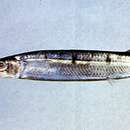Diagnostic Description
provided by Fishbase
Greatly prolonged, beak-like lower jaw; upper jaw short, triangular and without scales; preorbital ridge absent; total number of gill rakers on first gill arch 25-36; pectoral fins short, not reaching past nasal pit when folded forward; with 3-9 (usually 4-6) vertical bars on the sides. (Ref. 9843). Color bluish dorsally, silvery on sides. 36-41 predorsal scales. Lower lobe of caudal fin longer than upper lobe. Dorsal and anal fins located posteriorly.Description: Characterized by dorsal fin yellowish; blue lower lobe and yellowish upper lobe caudal fin; tip of lower jaw, red; depth of body 5.7-7.3 in SL; well developed anterior lobe of dorsal fin; width of body contained 1.3-1.8 in its depth; lower lobe of caudal fin longer than upper (Ref. 90102).
- Recorder
- Estelita Emily Capuli
Morphology
provided by Fishbase
Dorsal spines (total): 0; Dorsal soft rays (total): 12 - 15; Analspines: 0; Analsoft rays: 10 - 12
- Recorder
- Estelita Emily Capuli
Trophic Strategy
provided by Fishbase
Surface-dwelling omnivores. Lives in coastal waters of high islands and continental shorelines (Ref. 1602); also inhabits coral reefs (Ref. 1937, 58534). Present in seagrass beds at all life stages (Ref. 41878). Feeds on fish, plants, and zooplankton (Refs. 1602, 127989). Schooling species. Epipelagic inshore (Ref. 127989).
- Recorder
- Estelita Emily Capuli
Biology
provided by Fishbase
Occur in coastal waters of high islands and continental shorelines; generally in areas rich in vegetation (Ref. 5213) and sand flats (Ref. 48635). Form schools. Adults feed mainly on seagrasses, to a lesser extent on green algae and diatoms (Ref. 9843). Breed in estuaries (Ref. 4164). Marketed fresh and dried salted (Ref. 5284, 9843); meat tasty (Ref. 637). Also caught with dragnets (Ref. 30573) and dipnets.
- Recorder
- Estelita Emily Capuli
Importance
provided by Fishbase
fisheries: commercial; gamefish: yes; bait: occasionally
- Recorder
- Estelita Emily Capuli
分布
provided by The Fish Database of Taiwan
廣泛分布於印度-西太平洋區,西起紅海、非洲東岸,東至薩摩亞,北至日本南部,南至澳洲北部水域及新加勒多尼亞。臺灣除東南部水域外,皆可發現。
利用
provided by The Fish Database of Taiwan
春夏之間為盛漁期,可利用流刺網、圍網、定置網等漁法捕獲。成魚肉質味美,用油煎食味道不錯,鹽漬亦可。幼魚偶作為觀賞魚,有趣可愛。
描述
provided by The Fish Database of Taiwan
體延長,側扁,標準體長為頭長之3.8-4.6倍,為體高之5.3-6.2倍。眼前脊缺如。上頜短,突出成三角形,其上無鱗;下頜突出如喙,其長不小於頭長;鋤骨及舌上無齒。鼻窩內具一圓形或扇形嗅瓣。第一鰓弓上鰓耙25-36(通常為29-33)。鰾為多室型。背前鱗數32-39(通常為34-37);側線位低,近腹緣。背鰭與臀鰭對在,臀鰭起點在背鰭第6-8軟條之下方,背鰭具12-14軟條,臀鰭具10-12軟條;雄魚之臀鰭不變形;胸鰭短,標準體長為胸鰭長之5.4-6.6倍,具
11-13軟條;腹鰭短小,後位,其基底與尾鰭基底之間距遠短於其與鰓蓋後緣之間距;尾鰭叉形,下葉長於上葉。體背呈淺灰藍,腹部白色,體側中間有一條銀白色縱帶,另有3-9條(通常為4-6條)垂直暗斑;喙為黑色,前端具明亮之橘紅色。
棲地
provided by The Fish Database of Taiwan
主要棲息沿岸或島嶼四周較乾淨的水域表層,成群洄游,一般皆在水草較多的水域。容易受驚嚇,逃避敵害時,有時會有躍出水面的動作。以水層中的浮游生物為食。
Hemiramphus far
provided by wikipedia EN
Hemiramphus far, the halfbeak, black-barred halfbeak, black-barred garfish, barred halfbeak, barred garfish or spotted halfbeak, is a schooling marine fish in the family Hemiramphidae. It has an Indo-Pacific distribution and has invaded the eastern Mediterranean through the Suez Canal.
Description
Hemiramphus far has a laterally compressed body which is elongate oval in cross-section and has a very long, beak-like lower jaw with a short upper jaw which is triangular and lacks scales; there is no preorbital ridge. The total number of gill rakers on first gill arch is 25-36 with 21-27 on the second arch. It has short pectoral fins which do not extend past the nasal fossa when they are folded forwards. There are 3-9, normally 4-6, dark vertical bars on the sides and the back is bluish in colour with silvery sides. The caudal fin is asymmetrical with the lower lobe being longer than the upper lobe. The dorsal fin and the anal fin are located towards the tail. These fins are dark in colour. The meristic formula is D,12-15, A,10-12, P,11-13. The maximum length is 33 cm.[2][3]
Distribution
Hemiramphus far occurs in the Indian Ocean from the Red Sea and East Africa into the Pacific Ocean as far as Samoa, north to the Ryukyu Islands and south to northern Australia and New Caledonia. H. far was first recorded in the Mediterranean Sea off the coast of Palestine in 1927, following a likely migration through the Suez Canal and is now very abundant in the whole eastern Basin, with recent records off Algeria in the western Basin.[4][5]
Biology
Hemiramphus far is bathypelagic and is found in coastal waters of mountainous islands and continental shorelines; most frequently in areas of sea which are rich in vegetation and over sand flats. This is a sociable species which forms schools. The adults are largely phytovores feeding mainly on sea grasses and, to a lesser extent, on green algae and diatoms. It breeds in estuaries, and in the more temperate parts of its distribution in the spring and summer. The eggs are attached to vegetation by sticky threads and once the larvae hatch they are planktonic.[2][3]
Fisheries
Hemiramphus far is commercially exploited along the Arabian Sea coast of Pakistan where the species is considered of great economic importance.[5] It is caught with drag nets and dip nets[2] but is reported to escape from nets by leaping over them.[5] The flesh is considered to be flavoursome and it is marketed both in fresh form and dried.[6]
Etymology
Hemiramphus far was described in 1775 by the Swedish zoologist Peter Forsskål as Esox far but the generic name Hemiramphus which is from the Greek hemi meaning "half" and rhamphos meaning "a bill" or "a peak" was coined by the French naturalist Georges Cuvier in 1816.[1][2][7]

Hemiramphus far Mintern 120
References

- license
- cc-by-sa-3.0
- copyright
- Wikipedia authors and editors
Hemiramphus far: Brief Summary
provided by wikipedia EN
Hemiramphus far, the halfbeak, black-barred halfbeak, black-barred garfish, barred halfbeak, barred garfish or spotted halfbeak, is a schooling marine fish in the family Hemiramphidae. It has an Indo-Pacific distribution and has invaded the eastern Mediterranean through the Suez Canal.
- license
- cc-by-sa-3.0
- copyright
- Wikipedia authors and editors
Description
provided by World Register of Marine Species
Occurs in coastal waters of high islands and continental shorelines; generally in areas rich in vegetation (Ref. 5213). Forms schools. In Okinawa, it is seen leaping above the water surface. Adults feed mainly on sea grasses, to a lesser extent on green algae and diatoms (Ref. 9843). Marketed fresh and dried salted (Refs. 5284; 9843); meat tasty (Ref. 637). Also caught with dip nets.
Froese, R. & D. Pauly (Editors). (2023). FishBase. World Wide Web electronic publication. version (02/2023).
- license
- cc-by-4.0
- copyright
- WoRMS Editorial Board

